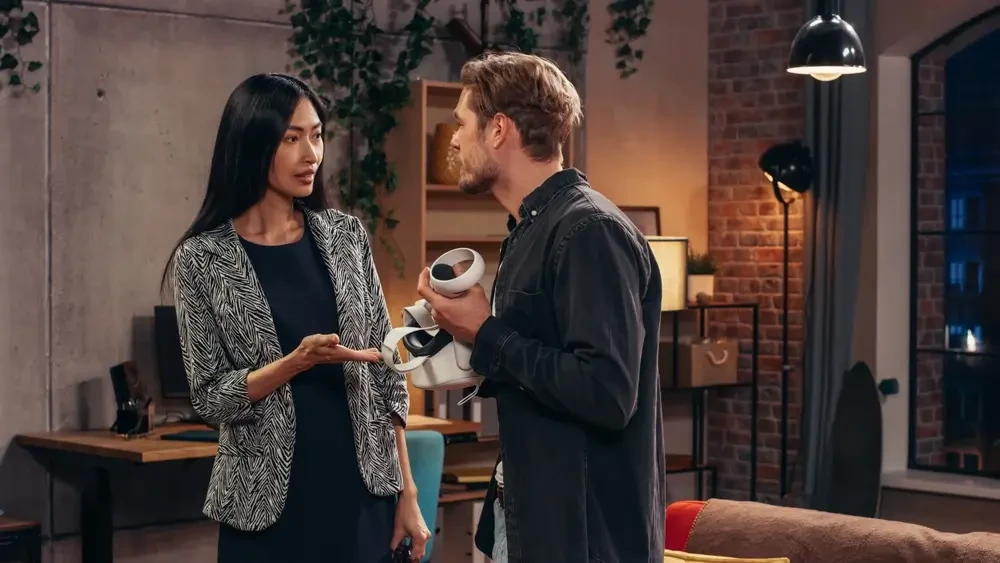Key Takeaways
- Sitcoms feature humor in everyday settings with a consistent set of characters.
- Types include multi-camera, workplace, domestic, and dramatic comedies, each offering unique humor styles.
- Key characteristics include familiar settings, recurring characters, laugh tracks, and episodic formats.
- Sitcoms have evolved over the decades, reflecting societal changes and embracing new themes and technologies.
Sitcoms, short for “situation comedies,” are a beloved genre of television shows known for their lighthearted humor, relatable characters, and recurring situations. These shows typically feature a fixed set of characters placed in familiar settings, such as a family home, workplace, or social gathering spot.
Here’s a comprehensive guide to understanding sitcoms, including their definition, key characteristics, popular examples, and why they continue to captivate audiences worldwide.
Sitcom Definition
A sitcom, short for situational comedy, is a genre of television comedy that features a consistent cast of characters navigating humorous situations within a fixed setting, such as a home, workplace, or community. Each episode typically presents a self-contained story, often revolving around relatable scenarios and character-driven humor. While traditionally filmed in front of a live studio audience with a multi-camera setup, modern sitcoms may employ single-camera formats and vary in style and tone.
Famous Sitcom Examples
- Friends
- Seinfeld
- Brooklyn Nine Nine
Types of Sitcoms
Sitcoms come in various forms, each offering a unique flavor of humor and storytelling. Understanding these types helps in appreciating the genre’s diversity and creativity.

The Multi-Cam
Multi-camera sitcoms are traditionally shot on a set with a live studio audience, akin to a stage play. Classics like “Friends” and “The Big Bang Theory” are examples. This format is known for its fast-paced dialogue, laugh tracks, and a focus on verbal humor. The presence of a live audience often enhances the actors’ performances, creating a lively and dynamic atmosphere.
The Workplace Comedy
This sub-genre focuses on the daily lives of people at their place of work. Shows like “The Office” and “Parks and Recreation” are prime examples. Workplace comedies are often characterized by an ensemble cast, allowing for a variety of character interactions and humorous situations arising from work-related scenarios. They often include satirical elements and social commentary.
The Domestic Comedy
Centering around family life and domestic settings, these sitcoms often explore themes of family dynamics, parenting, and relationships. Classics like “The Cosby Show” and modern hits like “Modern Family” fall into this category. They provide a window into the changing face of families and societal norms, often with a heartwarming and humorous approach.
The Dramatic Comedy
Also known as “dramedy,” these shows blend elements of drama and comedy. Series like “Orange is the New Black” and “Atlanta” exemplify this style. Dramatic comedies often tackle serious themes and real-life issues, using humor as a tool for commentary and storytelling. They challenge traditional sitcom norms, offering deeper character development and more complex narratives.
Key Characteristics of Sitcoms
Sitcoms share several defining characteristics. One of the most prominent features is their setting. Typically, a sitcom unfolds in a consistent environment, like a family home, workplace, or a local hangout spot. This familiarity of setting helps audiences form a bond with the characters and their world.

Key Characteristics
- Laugh Track: Many traditional sitcoms use a laugh track, which is pre-recorded laughter inserted into the show to cue the audience’s response to jokes and humorous situations.
- Recurring Characters: Sitcoms often feature a core group of characters whose interactions and relationships drive the plot forward. These characters may include family members, friends, coworkers, or neighbors.
- Familiar Settings: Sitcoms are typically set in familiar environments like homes, workplaces, schools, or community spaces. The familiarity of the setting helps viewers relate to the characters and situations.
- Episodic Format: Each episode of a sitcom presents a self-contained storyline or comedic premise. While there may be ongoing character development and story arcs, episodes can generally be watched independently of one another.
- Humor Styles: Sitcoms employ various humor styles, including verbal wit, physical comedy, satire, and situational humor. The blend of these comedic elements contributes to the show’s overall appeal.
Evolution of the Sitcom Genre
The history of sitcoms is a fascinating journey that mirrors the evolution of television and society itself. The earliest sitcoms, emerging in the 1950s, such as “I Love Lucy” and “The Honeymooners,” set the template for the genre. They focused on domestic life and relatable family issues, resonating with the audience of that era.
Sitcoms in 70s and 80s
As the decades passed, the themes and styles of sitcoms evolved. The 1970s and 1980s saw sitcoms like “All in the Family” and “Cheers” tackling social issues and introducing ensemble casts, broadening the genre’s scope. This period also witnessed the rise of workplace sitcoms, offering a comedic take on professional life.
Sitcoms in 90s and 00s
The 1990s and early 2000s marked a golden age for sitcoms, with shows like “Friends,” “Seinfeld,” and “The Office” achieving both critical acclaim and popular success. These sitcoms revolutionized the genre with their unique storytelling methods, character-driven humor, and foray into unconventional themes.
Notable Examples of Popular Sitcoms
Throughout its history, the sitcom genre has produced some truly iconic shows that have left an indelible mark on popular culture. Let’s highlight a few notable examples:
- “I Love Lucy” (1951-1957): This groundbreaking sitcom, starring Lucille Ball and Desi Arnaz, set the standard for the genre. Its mix of slapstick humor, lovable characters, and innovative production techniques made it a television milestone.
- “The Mary Tyler Moore Show” (1970-1977): A pioneering show that introduced a strong, independent female lead character, it was significant for its portrayal of a single woman pursuing her career, a rarity at the time.
- “Cheers” (1982-1993): Set in a Boston bar, this sitcom became known for its witty script, ensemble cast, and the warm, inclusive atmosphere it created, which made viewers feel like a part of the Cheers family.
- “Seinfeld” (1989-1998): Often described as “a show about nothing,” “Seinfeld” turned everyday situations into comedy gold. Its unique humor and strong character dynamics have made it a timeless classic.
- “Friends” (1994-2004): A cultural phenomenon of the 90s, “Friends” was notable for its focus on the lives, relationships, and careers of six friends living in New York City, combining humor with relatable life issues.
- “The Office” (US, 2005-2013): An adaptation of the UK series, this mockumentary-style sitcom offered a humorous look at everyday office life, known for its deadpan humor and unforgettable characters.
- “The Big Bang Theory”: Centered around a group of socially awkward scientists and their interactions with friends, family, and romantic partners, this sitcom explores themes of friendship, love, and nerd culture.
- “Brooklyn Nine-Nine”: Combining comedy with crime procedural elements, this sitcom follows the detectives of the fictional 99th precinct in Brooklyn, New York, as they solve cases and bond as a dysfunctional yet lovable team.
Sitcoms in the Modern Era
Streaming services have risen, freeing sitcoms from the traditional network television format and giving more creative freedom in terms of storytelling, episode length, and release strategies.

sitcoms in the Modern Era
Modern sitcoms are increasingly exploring diverse themes and inclusive narratives. Shows like “Master of None,” “The Good Place,” and “Brooklyn Nine-Nine” are examples of how sitcoms have become more reflective of societal diversity, tackling topics like race, sexuality, and ethics with humor and sensitivity.
The use of technology has also changed how sitcoms are produced and consumed. High-definition filming, the absence of laugh tracks, and more cinematic approaches are becoming common. Additionally, the binge-watching culture has influenced the narrative structure of sitcoms, with more emphasis on story arcs that span across episodes or entire seasons.
FAQs
What defines a sitcom?
A sitcom is a television comedy featuring recurring characters in humorous situations within a fixed setting. Episodes usually focus on relatable scenarios and character-driven humor.
What is a sitcom example?
An example of a sitcom is Friends, which follows six friends in New York City navigating life and relationships with humor.
What are the three types of sitcoms?
The three types are traditional sitcoms (multi-camera), single-camera sitcoms, and animated sitcoms.
What is the difference between a sitcom and a comedy-drama?
A sitcom focuses mainly on humor, while a comedy-drama blends comedy with more serious or emotional elements.
Closing Thoughts
Whether you’re a longtime fan or new to the genre, sitcoms offer a delightful blend of laughter, heartwarming moments, and timeless entertainment. So grab your favorite snacks, settle into your comfiest spot on the couch, and enjoy the comedic adventures of your favorite sitcom characters!
Check out 5 best video production management software
About RFM
RFM is a web-based video, TV, and film production management software that offers various features for professionals in the entertainment industry. It allows users to write professional project briefs and descriptions, talent, and actor showcases, visualize scenes with shot lists, media sharing and manage various aspects of production, including call sheets, shooting schedules, and script breakdowns. RFM is designed to help teams collaborate more effectively during the production process, making it a valuable tool for filmmakers, photographers, and video production companies.
Read more of our articles here: Who is MUB Lite SEO?